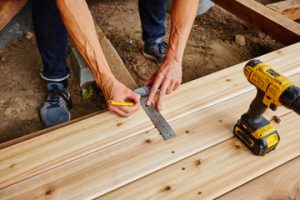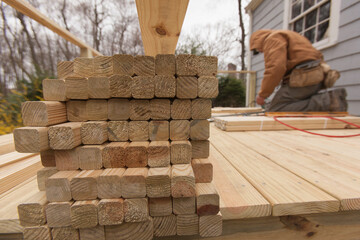A well-constructed deck can completely transform a backyard or outdoor area, providing a functional space for entertaining, relaxation, and family activities. Deck building is not just about laying boards and installing railings; it requires careful planning, design expertise, and attention to detail to ensure both aesthetics and structural integrity.
For homeowners looking to enhance their property, professional deck building Contractors Murfreesboro TN offer a way to create customized outdoor living spaces that are visually appealing, safe, and built to last for years.

One of the first steps in deck building is design planning. The design phase involves evaluating the property’s layout, available space, and existing landscape features. A well-planned deck complements the architecture of the home, integrates with outdoor elements, and maximizes the usability of the space. Professional deck builders often provide design consultation services, helping homeowners visualize layouts, consider multi-level or wrap-around options, and incorporate features such as built-in seating, pergolas, planters, or outdoor kitchens. Thoughtful planning ensures that the deck is not only attractive but also functional and tailored to the homeowner’s lifestyle and needs.
Material selection plays a crucial role in deck building. Different materials offer varying levels of durability, maintenance requirements, and visual appeal. Common options include natural wood, pressure-treated lumber, composite decking, and PVC materials. Natural hardwoods such as cedar or redwood provide rich color and natural beauty but require regular sealing and maintenance to prevent weathering and decay. Composite decking offers low-maintenance durability with resistance to rot, insects, and fading, making it a popular choice for modern decks. PVC and other synthetic materials provide long-lasting, weather-resistant options that require minimal upkeep. Professional deck builders guide homeowners in selecting the right material based on budget, climate, desired appearance, and maintenance preferences.
Structural integrity is a key consideration in deck building. A deck must be able to support the weight of people, furniture, and accessories while maintaining safety and stability over time. Professional deck builders understand load-bearing calculations, proper framing techniques, and the correct installation of footings, joists, and beams. They also ensure compliance with building codes, safety standards, and permit requirements, minimizing the risk of accidents or structural failure. Investing in professional construction ensures that the deck is secure, reliable, and capable of withstanding environmental challenges such as wind, rain, and temperature fluctuations.
Two major advantages of professional deck building include:
- Customization and Personalization: Professional builders can create decks tailored to specific needs, including size, layout, features, and materials, ensuring the space aligns with the homeowner’s lifestyle and aesthetic preferences.
- Expert Project Management: Experienced builders handle all aspects of the project, from initial design and material selection to construction, finishing, and cleanup, providing a seamless and efficient experience for the homeowner.
Deck building also involves careful attention to finishing details. Railings, stairs, trim, and surface treatments contribute both to safety and visual appeal. Proper installation of railings and stairs ensures compliance with safety codes and provides secure access to elevated areas. Surface treatments such as sealing, staining, or painting enhance durability, protect against moisture and UV damage, and extend the lifespan of the deck. Professional builders have the expertise to execute these finishing touches correctly, resulting in a polished, attractive, and long-lasting outdoor space.
Maintenance considerations are another important aspect of deck building. Even the most durable materials benefit from periodic upkeep to preserve their appearance and functionality. Regular cleaning, sealing, and inspection help prevent issues such as mold, mildew, rot, or fading. Professional builders often provide guidance on maintenance schedules, recommended cleaning techniques, and the best products for protecting the deck. By following expert recommendations, homeowners can ensure that their investment continues to look great and remains safe for years to come.
Deck building is not limited to residential properties; commercial properties can also benefit from professionally constructed decks. Restaurants, hotels, resorts, and recreational facilities often require outdoor seating, entertainment areas, or landscaped patios that are safe, durable, and visually appealing. Professional deck builders design and construct commercial decks to accommodate heavy foot traffic, withstand frequent use, and meet safety regulations. The result is a functional and attractive outdoor space that enhances the customer experience and contributes to the overall success of the business.
Design flexibility is a hallmark of professional deck building. Decks can be constructed in various configurations, including single-level, multi-level, wrap-around, or rooftop decks. Features such as built-in benches, lighting, planters, and pergolas can be incorporated to enhance functionality and style. Outdoor kitchens, fire pits, and seating areas further expand the deck’s usability, making it an ideal space for entertaining, dining, and relaxing. Professional builders work with homeowners to balance design, functionality, and budget, ensuring that every deck is customized to meet unique needs and preferences.
Environmental considerations are increasingly important in deck building. Eco-friendly materials, sustainable wood sources, and water-resistant treatments are all factors that contribute to a greener, longer-lasting deck. Professional builders often provide recommendations for environmentally responsible materials and construction methods, ensuring that the deck is both durable and eco-friendly. Choosing sustainable options not only benefits the environment but also enhances the longevity and maintenance efficiency of the deck.
Budget and cost management are essential when planning a deck project. Professional builders provide transparent estimates, detailed breakdowns of materials and labor, and guidance on cost-effective solutions. This allows homeowners to make informed decisions and maximize value without compromising quality. While DIY approaches may seem more affordable, professional construction ensures structural integrity, aesthetic appeal, and long-term durability, often resulting in greater value over time. Contractors also help homeowners avoid costly mistakes, such as improper materials or construction errors, that can lead to repairs or replacement in the future.
Communication and collaboration are key to a successful deck-building project. Professional builders maintain clear and consistent communication throughout all stages, from initial consultation and design to construction and final inspection. They address questions, provide expert recommendations, and keep homeowners informed about progress and scheduling. Strong collaboration ensures that the final deck aligns with the homeowner’s vision while meeting safety and functional requirements. Contractors who prioritize customer satisfaction and transparency are more likely to deliver high-quality results and a positive overall experience.
Seasonal and climate considerations also influence deck building decisions. Outdoor surfaces are exposed to sun, rain, snow, and temperature changes, all of which impact material selection, structural design, and finishing treatments. Professional deck builders account for these factors when designing and constructing decks, ensuring long-lasting performance in any climate. Proper planning and construction prevent common issues such as warping, cracking, fading, or water damage, allowing homeowners to enjoy their outdoor spaces throughout the year.
In conclusion, professional deck building offers homeowners the opportunity to create customized, durable, and visually appealing outdoor spaces. From design and material selection to construction, finishing, and maintenance guidance, expert builders provide comprehensive services that ensure long-term satisfaction. Customized designs, quality materials, attention to structural integrity, and finishing details all contribute to the creation of a deck that enhances property value and usability. Investing in professional deck building not only delivers functional and attractive outdoor living areas but also provides peace of mind, knowing that the deck is safe, durable, and built to last. By choosing experienced professionals, homeowners can enjoy a beautiful outdoor space that serves as a central gathering place, entertainment area, and sanctuary for relaxation for years to come.
